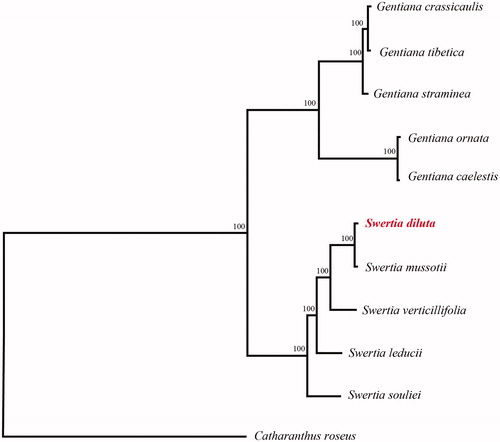Abstract
Swertia diluta, a traditional Chinese medicine, is widely used to treat jaundice hepatitis, dysentery, dyspepsia, etc. The plastome is 153,691 bp in length, with one large single copy region of 83,860 bp, one small single copy region of 18,301 bp, and two inverted repeat (IR) regions of 25,765 bp. It contains 134 genes, including 84 protein-coding genes, 8 ribosomal RNA, and 37 transfer RNA. Phylogenetic tree shows that S. diluta is a sister species to S. mussotii. The complete chloroplast genome could provide genetic information of this species would contribute to the formulation of protection strategy.
Swertia diluta (Turcz.) Benth. et Hook. f. belongs to Swertia (Gentianaceae), is a traditional Chinese medicine (Ho and Liu Citation2001), This medicinal plant is widely used to treatment jaundice hepatitis, dysentery, dyspepsia and other diseases. However, due to anthropogenic over exploitation and decreasing distributions, this species needs urgent conservation. Knowledge of the genetic information of this species would contribute to the formulation of protection strategy (Xiao et al. Citation2010). As one of important target for genetic transformation, the full chloroplast genome could supply more genetic information. So far, the chloroplast genome of S. diluta has not been reported. In this study, we reported the complete chloroplast genome sequence of S. diluta based on the next-generation sequencing, and the annotated genomic sequence was submitted to GenBank.
Fresh leaves of S. diluta were collected from Nanhuashan mountain (Zhongwei, Ningxia, China; coordinates: 105°38′E, 36°21′N) and dried with silica gel. The voucher specimen was stored in Sichuan University Herbarium with the accession number of QTPLJQ13383005. Total DNA was isolated using a modified CTAB method (Doyle and Doyle Citation1987) and sequenced by the BGISEQ-500 sequencing platform (BIG, Shenzhen, China). A total 10 million high quality pair-end reads were used to assemble the complete chloroplast genome by NOVOPlasty (Dierckxsens et al. Citation2017). The complete chloroplasts genome sequence of S. leducii was used as a reference. Plann v1.1 (Huang and Cronk Citation2015) and Geneious v11.0.3 (Kearse et al. Citation2012) were used to annotate the chloroplasts genome and correct the annotation.
The total plastome length of S. diluta (MT588299) is 153,691 bp, exhibits a typical quadripartite structural organization, consisting of a large single copy (LSC) region of 83,860 bp, two inverted repeat (IR) regions of 25,765 bp, and a small single copy (SSC) region of 18,301 bp. The cp genome contains 134 complete genes, including 84 protein-coding genes (84 PCGs), eight ribosomal RNA genes (4 rRNAs), and 37 tRNA genes (37 tRNAs). Most genes occur in a single copy, while 14 genes occur in double, including seven tRNAs (trnA-UGC, trnI-CAU, trnI-GAU, trnL-CAA, trnN-GUU, trnR-ACG, and trnV-GAC), and seven PCGs (rps7, rps19, rpl2, rpl23, ndhB, ycf15, ycf2), while one partial rps19 gene was identified as a pseudogene. The overall AT content of cp DNA is 61.9%, the corresponding values of the LSC, SSC, and IR regions are 63.8%, 68.1%, and 56.5%.
To confirm the phylogenetic location of S. diluta within the family of Gentianaceae, a total of 10 complete cp genomes of Gentianaceae were obtained from GenBank, and Catharanthus roseus was used as out-group. All the sequences were aligned using MAFFT v.7.313 (Katoh and Standley Citation2013) and maximum likelihood phylogenetic analyses were conducted using RAxML v.8.2.11 (Stamatakis Citation2014). The phylogenetic tree shows that all species were identified two clades. G. ornata, G. caelestis, G. straminea, G. crassicaulis and G. tibetica together one clustered. Remian species together another clustered, While S. diluta is a sister species to S. mussotii in this clade ().
Figure 1. A plastome phylogenetic tree of Gentianaceae species. GenBank accession numbers: Swertia diluta (MT588299); Swertia souliei (MT185926); Swertia leducii (NC_045301); Swertia verticillifolia (MF795137); Swertia mussotii (NC_031155); Gentiana ornata (NC_037983); Gentiana caelestis (MG192304); Gentiana straminea (KJ657732); Gentiana crassicaulis (NC_027442); Gentiana tibetica (NC_030319); Catharanthus roseus (NC_021423).

Disclosure statement
No potential conflict of interest was reported by the author(s).
Data availability statement
The data that support the findings of this study are openly available in GenBank of NCBI at https://www.ncbi.nlm.nih.gov, reference number MT588299.
Additional information
Funding
References
- Doyle JJ, Doyle JL. 1987. A rapid DNA isolation procedure for small quantities of fresh leaf tissue. Phytochem Bull. 19:11–15.
- Dierckxsens N, Mardulyn P, Smits G. 2017. NOVOPlasty: de novo assembly of organelle genomes from whole genome data. Nucleic Acids Res. 45(4):e18.
- Ho TN, Liu SW. 2001. A Worldwide Monograph of Gentiana. Beijing: Science Press.
- Huang DI, Cronk Q. 2015. Plann: a command-line application for anno-tating plastome sequences. Appl Plant Sci. 3(8):1500026.
- Katoh K, Standley DM. 2013. MAFFT multiple sequence alignment software version 7: improvements in performance and usability. Mol Biol Evol. 30(4):772–780.
- Kearse M, Moir R, Wilson A, Stones-Havas S, Cheung M, Sturrock S, Buxton S, Cooper A, Markowitz S, Duran C, et al. 2012. Geneious basic: an integrated and extendable desktop software platform for the organization and analysis of sequence data. Bioinformatics. 28(12):1647–1649.
- Stamatakis A. 2014. RAxML version 8: a tool for phylogenetic analysis and post-analysis of large phylogenies. Bioinformatics. 30(9):1312–1313.
- Xiao YC, Wei LX, Yang HX, Du Y. 2010. Quality control of traditional Tibetan medicine Swertia chirayita. J Chin Pharm Sci. 45:255–258.
